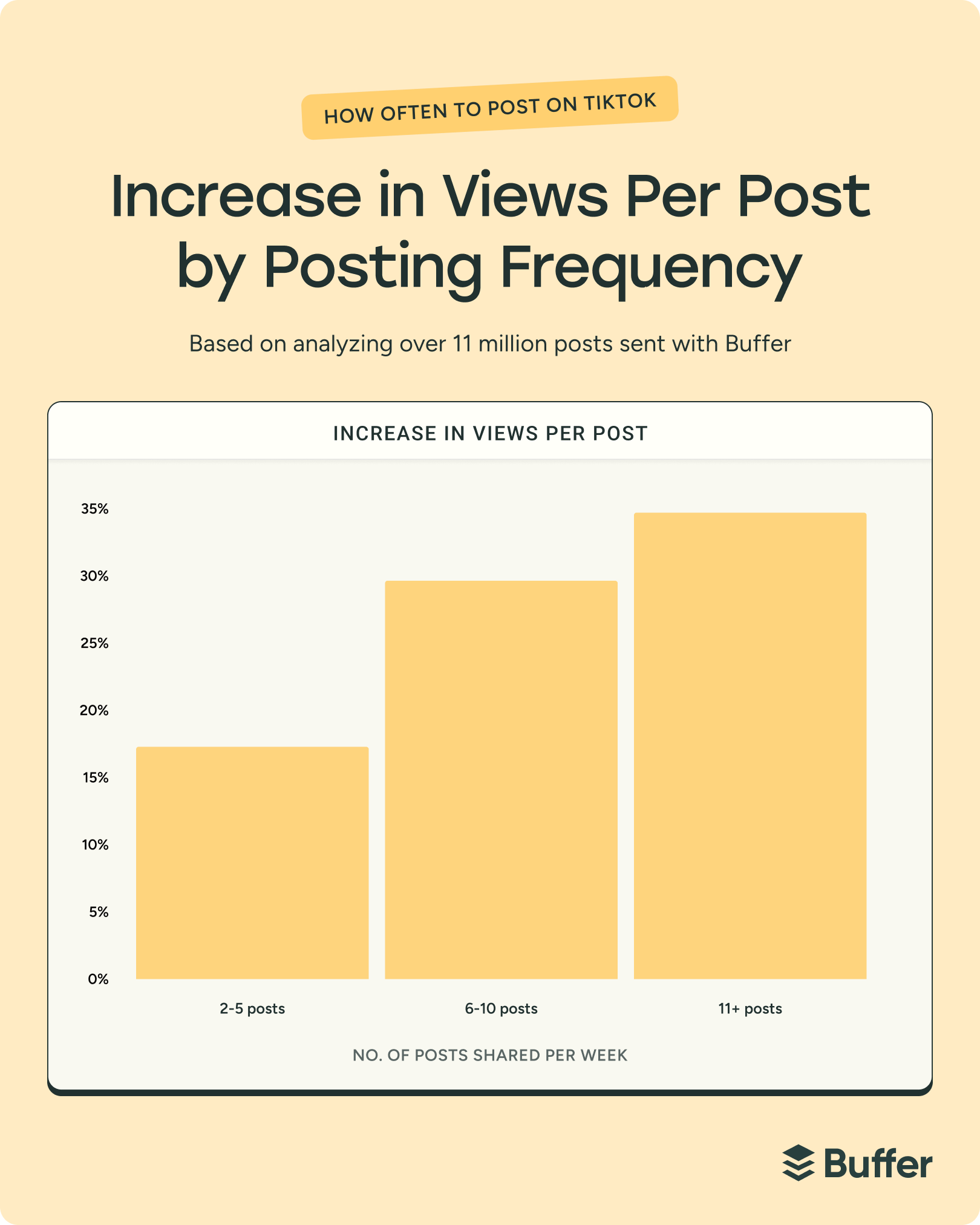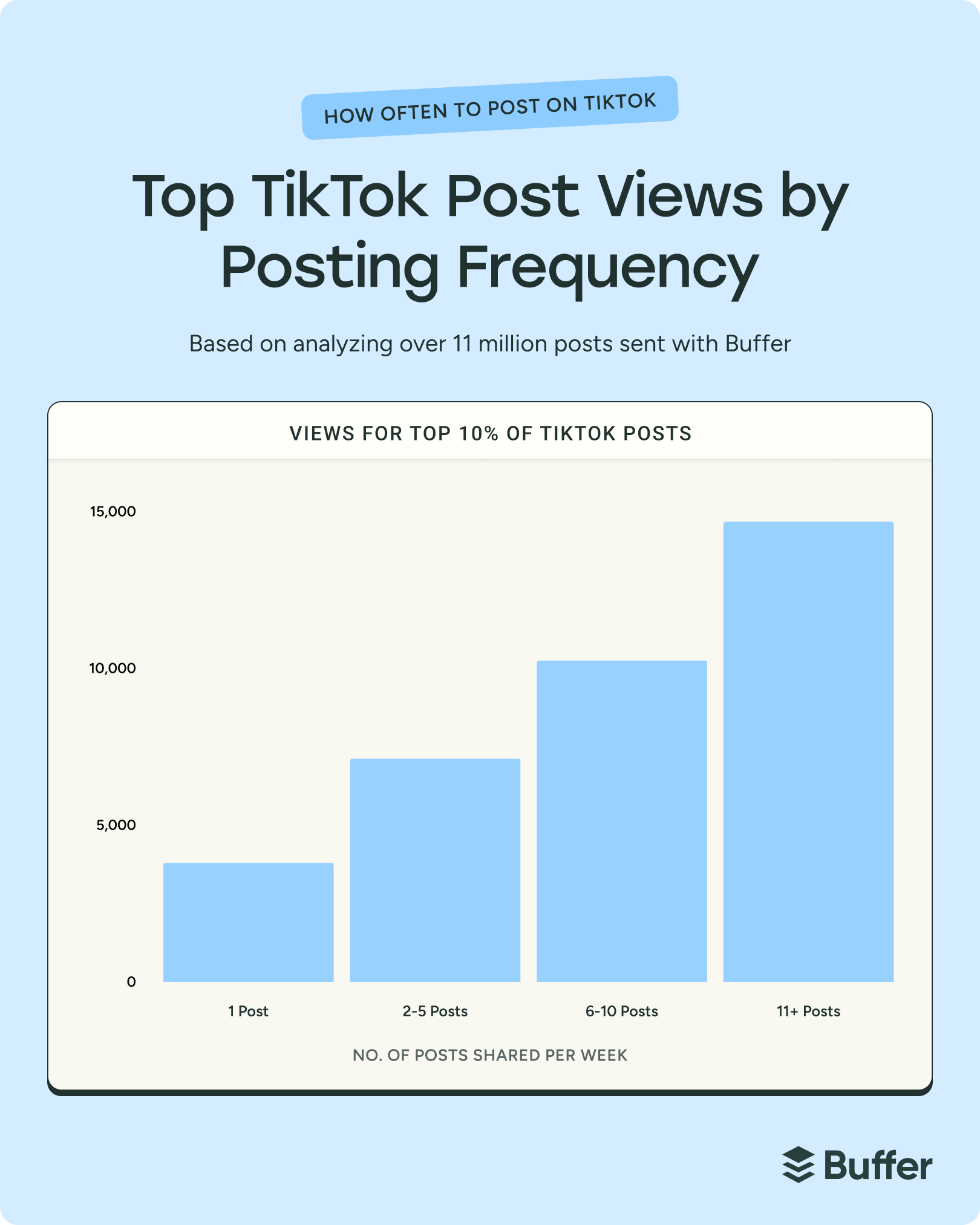Spend five minutes on the “how to grow” side of TikTok, and you’ll quickly learn one thing: if you’re not posting multiple times a day, you’re doing it wrong. Or so the algorithm experts say.
As a fledgling TikTok creator, I’ve always been a bit sceptical of this advice. I managed to build a small audience within about a year by posting a couple of times a month, rather than daily.
But… would I have been able to get more views on TikTok if I had?
I put the question to Buffer’s data scientist, Julian Winternheimer. And because he never does anything by halves, Julian analyzed a massive dataset to find the answer: 11.4 million TikTok posts from over 150,000 accounts.
We (by we, I mean Julian) went full science on this 2025 TikTok Study: running fixed-effects regressions and Z-score analyses to control for account size and performance differences.
The goal: To understand how posting frequency impacts your odds of success on TikTok.
If you’ve ever wondered how often you really need to post to grow on TikTok, this is for you.
Spoiler: The “post 3 times a day” crowd isn’t totally wrong… but the data tells a much more nuanced story.
💡
If you’re keen to dig into the data or you want some receipts for the recommendations we’re making below, scroll down to the section The study: How posting frequency affects views on TikTok.
How often should you post on TikTok?
The short answer: Aim for 2 to 5 posts per week. Our data shows that going from posting just once to 2 to 5 times per week on TikTok can offer the most meaningful lift in views.
However, posting more does mean more views — though not quite as many more as that first jump.
Julian’s analyses consistently showed that posting more often means more views per post. He found that TikTokers who go from posting once a week to:
- 2 to 5 times → get up to 17% more views per post
- 6 to 10 times → get up to 29% more views per post
- 11+ posts → get up to 34% more views per post
Yes, 11+ posts a week is a lot — and technically gives you the most significant average lift. But here’s the best bit (if you’re a creator with a day job like me):
The biggest jump happens when you go from 1 → 2 to 5 posts per week.
In other words, you’ll get the most reward for your efforts if you up your cadence from 1 to between 2 and 5 posts every week.
Of course, because TikTok is complicated, this doesn’t mean you’ll automatically start seeing an uptick in views, even if you jump to that 11+ posts per week cadence.
This is because the increase in views doesn’t come from a steady rise in performance per post but rather from the increased chances of breakout success. In fact, the median views per post stay pretty flat no matter how much you post. (More on this below).
The reason: Our analysis showed that the more you post, the greater your chances of going viral with a single post.
Let’s unpack that.
✨
How posting frequency affects views on TikTok — the study
Posting more means more views per post.
(I’m about to share some pretty impressive numbers, but there’s a lot of nuance here, so do read the next couple of sections and not just this one!)

Compared to just posting once per week, TikTokers who post:
- 2 to 5 times → 17% more views per post
- 6 to 10 times → 29% more views per post
- 11+ posts → 34% more views per post
Julian uncovered this with a fixed-effects regression model, which compares each account to itself over time. (Meaning it isolates the effect of frequency by removing account-level differences like follower count, niche, or brand strength.)
The highest lift is moving to 2 to 5 posts per week
Here’s some of that nuance: the returns are diminishing.
In other words, you’ll get the best bang for your buck when you go from 1 post per week to 2 to 5.
So yes, posting 11+ times a week brings the biggest lift. But the most efficient gain per extra post is in the 2 to 5 per week range.
If you’ve read our studies on how often to post on Instagram and LinkedIn, you’ll know this is true of those platforms, too.
Pretty convincing, right? Simply looking at the data above, we could reasonably conclude that TikTok seems to ‘reward’ users for posting more.
Well, that’s not exactly the case (buckle up, my friend).
More posts mean more chances to go viral
In some of Julian’s initial analyses, average views per post remained relatively steady, no matter how frequently users post. Similarly, the median views per post actually fall a bit at higher cadences.
So, er — what the heck is going on?
“This implies that the distribution of views per post becomes more skewed at higher posting frequency, even if the typical post doesn’t necessarily perform better,” Julian explains.
In other words: TikTok views are heavily skewed. Most posts get modest numbers, and a few go viral. So, looking at the mean or median views alone can miss what’s happening at the top end.
To better understand this, Julian sorted the view counts from lowest to highest and turned his magnifying glass on the top 10% of posts (aka the 90th percentile or p90)
This helps answer: “How much better are the best posts doing when people post more often?”
| Weekly Posts | Median Views | 90th Percentile Views | Viral Potential (p90/median ratio) |
|---|---|---|---|
| 1 Post | 489 | 3,722 | 7.6x |
| 2–5 Posts | 506 | 6,983 | 13.8x |
| 6–10 Posts | 487 | 10,092 | 20.7x |
| 11+ Posts | 459 | 14,401 | 31.4x |

Even though the median views per post stay around ~500, the top 10% of posts perform significantly better at higher cadences.
Hold up: what about smaller accounts?
Those p90 views per post numbers are impressive — and something you might not be used to seeing if you have a new or smaller account (🙋♀️). Does that mean increasing your posting frequency will only help when you have a larger account?
Not at all! Julian’s regression models controlled for that — and found that the relative gains hold true across all account sizes.
And remember, that 90% percentile was per post, not account. TikTok content performance is not as follower-dependent as a platform like Instagram. Even new creators can have viral posts.
Whether you have 500 followers or 50,000, increasing your posting cadence can help increase your chances of virality.
I really like this analogy: Posting more frequently doesn’t necessarily raise the floor, but it does raise the ceiling.
Post smarter, not just more
As always, remember that quantity is impactful, but quality will always be the most important factor in social media success.
So instead of stressing about daily uploads, focus on showing up consistently and making content you’re proud of. As our data shows, even increasing your output from one post to three posts per week can move the needle.
Julian summed it up best: “Posting more helps — but mostly because it increases your chances of getting lucky. TikTok is heavy-tailed. You only need one post to pop off. Posting more just increases your odds.”














![Top Resources for Giving Tuesday [Roundup]](https://mgrowtech.com/wp-content/uploads/2025/06/mq2.webp.webp)


